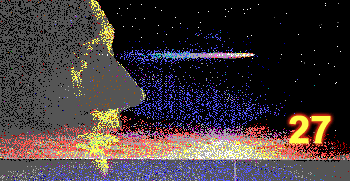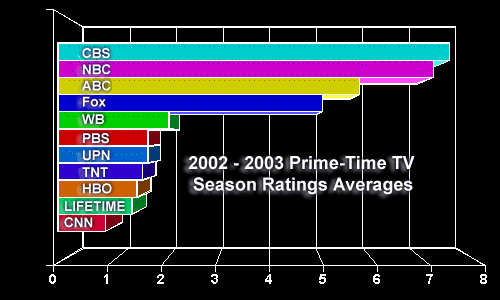Film, Radio and TV - 27 |
Public Broadcasting
This is largely a myth.
Public Broadcasting tends to fill the gaps in
commercial programming. PBS programming consistently wins awards Each year the National Academy of Television Arts and Sciences presents Emmy awards to networks to honor the best in news and documentary work. Note from the table on the right that that PBS won seven prestigious Emmy awards in 2003. Not on the list among the major networks is FOX News, which didn't win any Emmy awards that year. In terms of ratings, you will note that PBS came in sixth among the U.S. networks during the 2002-2003 season, ahead of A&E, Discovery, and Bravo (not shown).
Let's look at some aspects of Public Broadcasting. | ||||||||||||||
First, Public Broadcasting programming--both radio and television versions--represents a welcome refuge from the deluge of advertising we encounter in commercial broadcasting. Time is spent on fundraising and crediting corporate grants, but this doesn't add up to be anything like the 33% chunk of time (hourly average) we normally sit through with commercial broadcasting. Second, not being ratings driven, Public Broadcasting can present worthwhile (often award-winning) programming that will not necessarily have to appeal to a broad base of viewers (the LCD, or lowest common dominator). Most Public Broadcasting viewers have four or more years of college, and make more than $60,000 a year. This group contains a high percentage of corporate, political, and educational leaders and decision makers. Not included in the latter group is the large percentage of children 2-5 years of age that watch the many popular children's shows on PBS. Not only have programs such as "Sesame Street" won many awards, but for several decades, they have had a positive impact on the reading and math abilities of young children. Public Broadcasting has been able to tackle topics that are bypassed for various reasons by the commercial networks. For example, "The Rev. Moon in America" is an in-depth documentary into the hundreds of millions of dollars from a Korean religious organization, commonly referred to as "the Moonies," that surreptitiously supports many conservative causes. The documentary, based on a two-year investigation, revealed that the Rev. Moon has spent more than a billion dollars in the United States over the years--largely to influence U.S. public opinion and decision-making. (Interestingly, considerable effort was brought to bear to keep the documentary from airing.) To cite one more example, a PBS documentary on the U.S. invasion of Granada reveals a strikingly different story than the one promulgated by the U.S. government and subsequently by the mainstream press. (Most PBS programming is available on cassette for use in the classroom.)
Although documentaries like these reveal important information that voters in a democratic society should be aware of--information that might not otherwise come to light--they also draw sharp criticism. There is a clause in the 1967 public broadcasting law that expressly forbids government "direction, supervision, or control" of public broadcasting. It might be understandable that conservatives would see Public Broadcasting as being liberal; the demographics of public broadcasting listeners and viewers tend to lean in that direction. But probably the main, and largely unstated, objection to Public Broadcasting has been the fact that several documentaries, including the two previously cited, embarrassed some administrations by exposing disturbing facts--most of which were revealed by their own people. This has resulted in various types of pressure, including the reduction of funding, and even the delay of Public Broadcasting funds for a period of time. As a result, Public Broadcasting has had to start relying much more heavily on corporate funding. Consequently, Public Broadcasting is now more nervous about programming that goes against the interests of large corporations. Although
some system of "checks and balances" is
critical for the media, when political, religious,
or ideological pressures result in important information
and ideas being squelched, it affects the underlying
principle of a democracy, which depends on an informed
voting public. Even though many news stories are, for whatever reason, bypassed each year by the mainstream media, the Project Censored Group of Sonoma State University publicizes many of these stories in its yearly list of the Finally, Public Broadcasting has been on the forefront of technological innovation. Now that Public Broadcasting has moved into digital and high-definition television, it plans to expand into many more informational, educational, and cultural services. (Digital broadcasting provides for multiple services on a single broadcast frequency.) Only on Public Broadcasting can the blind can "watch" TV. Through a service called DVS (Descriptive Video Service) a second audio channel is used to provide a description of the action taking place on the screen. Being concerned that radio and television would be used solely for commercial purposes, nearly a half a century ago the Federal Communications Commission reserved both radio and TV channels for noncommercial stations. Subsequently,
the U.S. Congress established and funded
Public Broadcasting to "...encourage the growth and development of public broadcasting, including the use of radio and television for instructional, educational, and cultural purposes...." One
of the mandates was also to be active
in technological innovations. The Corporation for Public Broadcasting The CPB (Corporation for Public Broadcasting) was authorized by the Public Broadcasting Act of 1967 to assist in the development of a nationwide public broadcasting system. The CPB is a private, nonprofit corporation that oversees the growth of public television and radio in the United States. The CPB receives funding from the federal government and then disperses it to noncommercial stations for the production of radio and television programming. It also distributes direct grants to individual stations. In addition to federal money, the CPB receives numerous grants from foundations. The Ford Foundation, which was responsible for originally funding many noncommercial TV stations, and the Walter H. Annenberg foundation are just two examples. In order to be a Public Broadcasting affiliate, a noncommercial radio or TV station must meet certain operational standards. For this and other reasons, there are many noncommercial stations in the United States that are not affiliates. Many noncommercial stations, for example, are owned by religious groups. The CPB oversees PBS (the Public
PBS provides TV programming and related services to more than 350 noncommercial stations serving the 50 states, Puerto Rico, the U.S. Virgin Islands, Guam, and American Samoa. PBS programming is available to 99 percent of American homes with television sets, and its programming reaches nearly 100 million people each week. Of the PBS stations in the U.S., 51% represent community organizations, 32% colleges/universities,12% state authorities, and 5% local educational or municipal authorities. The wide range of weekly programming available on PBS can be seen by
Public radio in the United States dates back to the dawn of broadcasting, itself. In 1921, radio station 9XM (the forerunner of today's WHA-AM), started regular noncommercial programming from the University of Wisconsin. After this, many other stations followed and noncommercial radio enjoyed a brief burst of growth. But then growth was stifled--both by the economic chaos of the Depression and competition from commercial radio stations. Things picked up when congress passed the Public Broadcasting Act, which authorizing the creation of CPB. The act specifically called for the CPB to encourage "the growth and development of noncommercial radio" and to develop "programming that will be responsive to the interests of the people." Public radio, like public television, has responded to this mandate by filling a gap left by commercial radio stations. This even extends to small communities. For example, in many remote Alaskan villages with limited mail and telephone service, public radio stations are the primary means of communication, and frequently the only source of daily news. In some communities with large non-English-speaking populations, public radio provides a friendly place on the dial where people can hear programs in their native languages.
About 60 percent of NPR's operating income comes from member station dues and fees. Approximately 4 percent comes from CPB and other government and tax-funded sources. Gifts and grants from corporations, foundations, and individual supporters make up the balance. NPR has led important technological advances in radio, including establishing the first nationwide, satellite-delivered, U.S. radio distribution network in 1979. By clicking here you can hear the latest news from NPR. (As in the case of the other audio links, this requires a Real Audio™ player for your browser.)
PRI recently announced an agreement with CD Radio, Inc., to develop a full-time (24 hours per day) channel of public radio news, information, and entertainment programming. The Critics of Public Broadcasting Public Broadcasting isn't without its critics. James Ledbetter's recent book, Made Possible By..., is a well reviewed and extensively researched book that accuses Public Broadcasting of becoming dependent upon corporate financing. As a result, Public Broadcasting has become timid and fearful of offending big business, according to Ledbetter, and in that regard is now no different than commercial broadcasting. Whereas we used to have an bold, independent voice in Public Broadcasting, political and corporate pressures developed a stranglehold on their financing, and have made them fearful of offending the "hand that feeds them." The folks at Public Broadcasting would deny this, of course, and they can legitimately point to series such as the award-winning "Frontline," that frequently tackle controversial topics--although probably not many topics that directly challenge political or corporate interests. With the networks, the major newspapers, broadcast outlets, and even most magazines and book publishers now controlled by a handful of media conglomerates--and political contributions coming largely from these big business sources--many have begun to wonder just how free the U.S. media really is. This issue gained substance when a 2002 study revealed that among world nations, In the next module we'll look at the principles of TV programming. |
To next module To
index © 1996 - 2005, All Rights Reserved.
|

 Although Public Broadcasting is, on the average, viewed by wealthier and better-educated people, its programs cover a wide spectrum of interests.
Although Public Broadcasting is, on the average, viewed by wealthier and better-educated people, its programs cover a wide spectrum of interests. .
. 

 Broadcasting System), a private, nonprofit media enterprise owned and operated by the nation's 350 public television stations. The sources of funding for public television are shown below.
Broadcasting System), a private, nonprofit media enterprise owned and operated by the nation's 350 public television stations. The sources of funding for public television are shown below.
